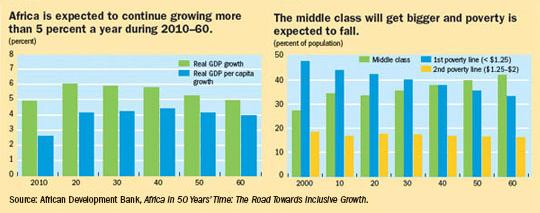Picture This
Africa: A Look into the Future
Finance & Development, December 2011, Vol. 48, No. 4
![]() IMF technical assistance in Liberia
IMF technical assistance in Liberia
What will the continent be like in 50 years’ time?

OVER the past decade, Africa has been growing at an unprecedented rate, despite the successive global food and financial crises. Although it will take decades of growth to make major inroads into Africa’s poverty, there is now growing optimism about the continent’s potential.
Africa has an abundance of natural resources and is the world’s most youthful continent (as a share of total population). If it invests more in its young people and in the hard and soft infrastructure required for growth, Africa could become one of the world’s most dynamic and productive economies, according to a new report from the African Development Bank (AfDB).
Growth and poverty

The report’s estimates—based on extrapolations of current economic performance—suggest that both economic output and output per capita will increase steadily between 2010 and 2060. By that time, most African countries—whose populations are expected to peak at 2.7 billion by 2060 (compared with 1 billion in 2010)—will attain upper-middle-income status.
One of the results of the strong economic growth of the past two decades has been a significant increase in the size of the African middle class (defined as those earning between $4 and $20 a day). The middle class will continue to grow—from 34 percent of Africa’s population in 2010 to 42 percent in 2060. Conversely, poverty rates are expected to fall, with the proportion of the population living on less than $1.25 a day declining from 44 percent in 2010 to 33 percent in 2060.

Technology and education
Africa will need substantial investment to ensure strong and sustainable growth over the next 50 years. Investments are needed in almost all the infrastructure subsectors—transportation, telecommunications, water and sanitation, and energy supply. Broadband penetration has picked up in the past five years, thanks to the continent’s efforts to develop that industry, and is expected to reach 99 percent of the population in 2060.
The ability to take advantage of new technologies will depend largely on human capital: a skilled workforce is essential for the adoption of new technologies and for globally competitive production. Access to primary, secondary, and higher-level education in Africa continues to increase, and literacy rates are expected to reach 96 percent in 2060, the AfDB says.

Health and mortality
Africa has already made important progress in improving the health of its population, a trend that is expected to continue. Child mortality is projected to decline from 127 per 1,000 live births in 2010 to 45 per 1,000 live births in 2060, largely thanks to higher incomes, improved water supply and sanitation, and better health services.
The HIV/AIDS prevalence rate is also projected to drop substantially, as a result of HIV prevention programs and improved access to antiretroviral treatment. However, malaria is still endemic in most African countries and continues to be a major cause of mortality on the continent.

Prepared by Natalie Ramírez-Djumena. Based on Africa in 50 Years’ Time: The Road Towards Inclusive Growth, published in September 2011 by an African Development Bank staff team led by Mthuli Ncube.


